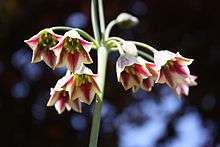Allium siculum
| Mediterranean bells Sicilian honey garlic Sicilian honey lily | |
|---|---|
 | |
| Allium siculum | |
 | |
| Allium siculum foliage | |
| Scientific classification | |
| Kingdom: | Plantae |
| Clade: | Angiosperms |
| Clade: | Monocots |
| Order: | Asparagales |
| Family: | Amaryllidaceae |
| Subfamily: | Allioideae |
| Genus: | Allium |
| Species: | A. siculum |
| Binomial name | |
| Allium siculum Ucria | |
| Synonyms[1][2][3] | |
|
Synonymy
| |
Allium siculum, known as honey garlic,[4] Sicilian honey lily, Sicilian honey garlic, or Mediterranean bells, is a European and Turkish species of plants genus Allium. It is native to the regions around the Mediterranean and Black Seas, and grown in other regions as an ornamental and as a culinary herb.[1]
Habitat and Description
Allium siculum is native to Turkey, Crimea, Greece, Bulgaria, Romania, southern France including Corsica, and Italy (Basilicata, Abruzzo, Umbria, Toscana, Sicily, Sardinia),[5] growing in damp, shady woods. It has showy clusters of gracefully drooping bell-shaped blossoms produced in May to early June sitting atop a tall green stem, to 1.2 m in height. The florets (blossoms), suspended on long drooping pedicels, are cream colored with a maroon streak down each petal, have white flared tips, and are tinted green at the base. The blossoms are followed by decorative, erect seed pods in late summer. The blue-gray foliage is triangular in cross-section and strongly twisting along the length of the ascending leaves.[6][7] A penetrating, skunky odor is released when the plant is cut.
Taxonomy
Allium siculum is a member of a small subgenus Nectaroscordum of Allium, which consists of only this species and Allium tripedale.[8]
- Subspecies[1]
- Allium siculum subsp. dioscoridis (Sm.) K.Richt. - Greece, Turkey, Bulgaria, Romania, Crimea
- Allium siculum subsp. siculum - France, Italy
Uses
Said to be resistant to deer and other herbivores, Allium siculum is used as a seasoning in Bulgaria . It is also planted in flower gardens because of the showy, drooping blossoms and unusual twisted foliage.
Properties
When Allium siculum is crushed, it gives off a chemical that makes the eyes water, similar to chopping onions. The lachrymatory agent (Z)-butanethial S-oxide, along with several 1-butenyl thiosulfinates are detected by mass spectrometry using a DART ion source. (Z)-Butanethial S-oxide (the higher homolog of syn-propanethial-S-oxide, the onion lachrymatory agent) isolated from the plant was shown to be identical to a synthetic sample. The precursor to the lachrymatory compound, (RS,RC)-(E)-S-(1-butenyl) cysteine S-oxide (homoisoalliin), was isolated from homogenates of A. siculum, and a closely related species, Allium tripedale, and fully characterized.[9][10]
References
- 1 2 3 Kew World Checklist of Selected Plant Families
- ↑ Plant List, Allium siculum
- ↑ Kubec, R.; Kim, S.; McKeon, D. M.; Musah, R. A. (2002). "Isolation of S-butylcysteine sulfoxide and six butyl-containing thiosulfinates from Allium siculum". Journal of Natural Products Chemistry 65: 960–964. doi:10.1021/np020064i.
- ↑ "BSBI List 2007". Botanical Society of Britain and Ireland. Archived from the original (xls) on 2015-02-25. Retrieved 2014-10-17.
- ↑ Altervista Flora Italiana, Aglio della Sicilia, Allium siculum
- ↑ "Allium Species Four". Pacific Bulb Society.
- ↑ "Nectaroscordum siculum". Royal Horticultural Society.
- ↑ Friesen, N.; Fritsch, R. M.; Blattner, F. R. (2006). "Phylogeny and new intrageneric classification of Allium (Alliaceae) based on nuclear ribosomal DNA ITS sequences" (pdf). Aliso 22: 372–395.
- ↑ Block, E. (2010). Garlic and Other Alliums: The Lore and the Science. Royal Society of Chemistry. ISBN 0854041907.
- ↑ Kubec, R.; Cody, R. B.; Dane, A. J.; Musah, R. A.; Schraml, J.; Vattekkatte, A.; Block, E. (2010). "Applications of DART Mass Spectrometry in Allium Chemistry. (Z)-Butanethial S-Oxide and 1-Butenyl Thiosulfinates and their S-(E)-1-Butenylcysteine S-Oxide Precursor from Allium siculum". Journal of Agricultural and Food Chemistry 58 (2): 1121–1128. doi:10.1021/jf903733e. PMID 20047275.